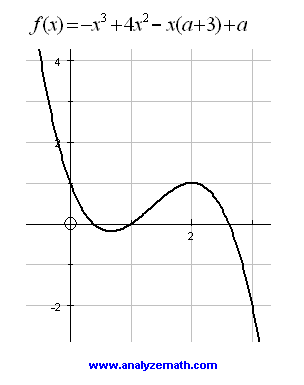Graphs of Third Degree Polynomials
The graphs of several third degree polynomials are shown along with questions and answers
at the bottom of the page.
- Polynomial of the third degree: cuts the x axis at one point.
Question 1: Why does the graph cut the x axis at one point only?

Figure 1: Graph of the third degree polynomial.
- Polynomial of the third degree: 3 x-intercepts.
Question 2: If the graph cuts the x axis at x = -2, what are the coordinates of the two other x-intercpets?

Figure 2: Graph of a third degree polynomial
- Polynomial of the third degree: 3 x intercepts and parameter a to determine.
Question 3: The graph below cuts the x axis at x = 1 and has a y-intercpet at y = 1. What are the coordinates of the two other x intercpets?

Figure 3: Graph of a third degree polynomial
- Polynomial of a third degree polynomial: one x-intercepts.
Question 4: The graph below cuts the x axis at x = -1. Why does the graph of this polynomial have one x intercept only?

Figure 4: Graph of a third degree polynomial, one intercpet.
Answers to Above Questions
- Since x = 0 is a repeated zero or zero of multiplicity 3, then the the graph cuts the x axis at one point.
- An x intercept at x = -2 means that Since x + 2 is a factor of the given polynomial. Hence the given polynomial can be written as: f(x) = (x + 2)(x2 + 3x + 1). Find the other zero, which give the two other x intercpets, by solving the equation x2 + 3x + 1 = 0. The solutions are: x = -3/2 + SQRT(5) / 2 and x = -3/2 - SQRT(5) / 2.
- Use the y intercept to find a = 1 and then proceed in the same way as was done in question 2 above to find the other 2 x intercepts: 3/2 - SQRT(5) / 2 and 3/2 + SQRT(5) / 2
- Factor f as follows: f(x) = (x + 1)(x2 + x + 1). In solving the equation x2 + x + 1 = 0, the zeros are complex numbers and therefore do not show as x intercepts.
More References and Links to Polynomial Functions
Polynomial Functions



